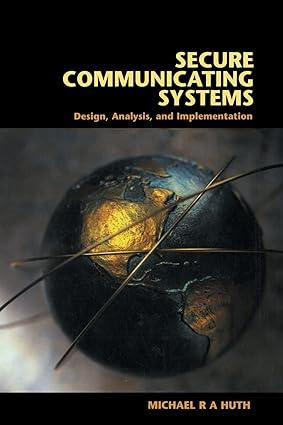8. Pseudo-random numbers L. Blum, M. Blum, and M. Shub designed a more effi- cient pseudo-random number
Question:
8. Pseudo-random numbers L. Blum, M. Blum, and M. Shub designed a more effi-
cient pseudo-random number generator with the additional property that the *i*th bit
*bi* can be computed "directly" from *i* and the seed *x0*. Use Miller-Rabin(*n*,*s*) to implement it as follows.
(a) Generate two large prime numbers, *p* and *q*, such that *p* = 3 mod 4 and *q* =
3 mod 4. (Which is more efficient to perform first: the test of whether *p* is prime, or the test of whether *p* and *q* both equal 3 mod 4?)
(b) Compute n = p ⋅ q; such an n, with p and q as in (a), is called a Blum integer.
(c) Choose a random integer x ∈ Z such that x has no common factor with n; note that this choice also depends on a pseudo-random generator – say, the one that Miller-Rabin(n,s) uses.
(d) Compute the seed x0 = x2 mod n for the pseudo-random number generator to be constructed.
(e) The ith bit bi of the new pseudo-random output sequence is the least significant bit of xi, where xi = x2i-1 mod n for all i ∈ N.
(f) Assume that xi = x02imod(p-1)-(q-1) mod n (2.14)
(2.15)
for all i ∈ N. (The mathematics required for showing this will be addressed in Exercise 2.11-12, p. 42.) The user of your algorithm should be able to choose whether the sequence is generated based on definition (2.14) or (2.15). Compare the efficiency of these versions.
Not only is this generator useful – since it allows us to compute the ith bit without having computed the previous bits of the sequence – it also has the pleasant property that the generated sequence is unpredictable to the left and right: one cannot predict the bit to the left (or right) of a given bit in the sequence.
Step by Step Answer:

Secure Communicating Systems Design Analysis And Implementation
ISBN: 9780521807319
1st Edition
Authors: Michael R. A. Huth





